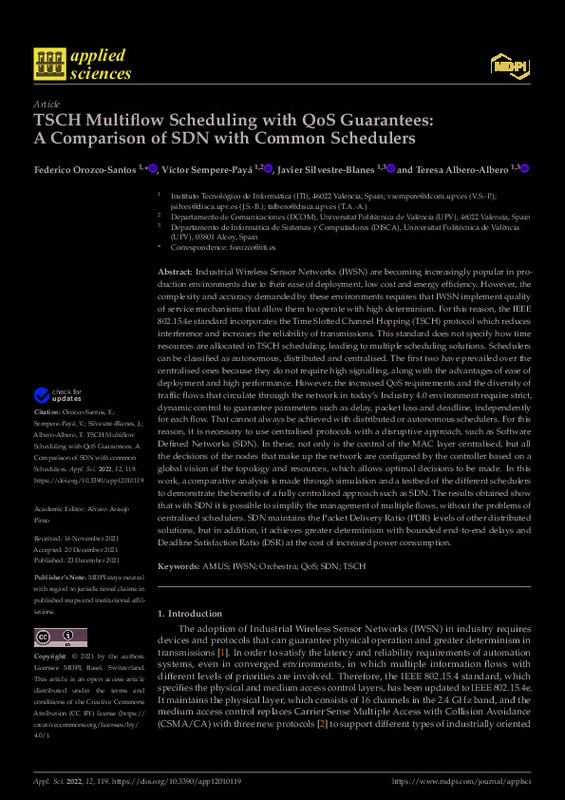|
Resumen:
|
[EN] Industrial Wireless Sensor Networks (IWSN) are becoming increasingly popular in production environments due to their ease of deployment, low cost and energy efficiency. However, the complexity and accuracy demanded ...[+]
[EN] Industrial Wireless Sensor Networks (IWSN) are becoming increasingly popular in production environments due to their ease of deployment, low cost and energy efficiency. However, the complexity and accuracy demanded by these environments requires that IWSN implement quality of service mechanisms that allow them to operate with high determinism. For this reason, the IEEE 802.15.4e standard incorporates the Time Slotted Channel Hopping (TSCH) protocol which reduces interference and increases the reliability of transmissions. This standard does not specify how time resources are allocated in TSCH scheduling, leading to multiple scheduling solutions. Schedulers can be classified as autonomous, distributed and centralised. The first two have prevailed over the centralised ones because they do not require high signalling, along with the advantages of ease of deployment and high performance. However, the increased QoS requirements and the diversity of traffic flows that circulate through the network in today's Industry 4.0 environment require strict, dynamic control to guarantee parameters such as delay, packet loss and deadline, independently for each flow. That cannot always be achieved with distributed or autonomous schedulers. For this reason, it is necessary to use centralised protocols with a disruptive approach, such as Software Defined Networks (SDN). In these, not only is the control of the MAC layer centralised, but all the decisions of the nodes that make up the network are configured by the controller based on a global vision of the topology and resources, which allows optimal decisions to be made. In this work, a comparative analysis is made through simulation and a testbed of the different schedulers to demonstrate the benefits of a fully centralized approach such as SDN. The results obtained show that with SDN it is possible to simplify the management of multiple flows, without the problems of centralised schedulers. SDN maintains the Packet Delivery Ratio (PDR) levels of other distributed solutions, but in addition, it achieves greater determinism with bounded end-to-end delays and Deadline Satisfaction Ratio (DSR) at the cost of increased power consumption.
[-]
|
|
Agradecimientos:
|
This work has been supported by DAIS (https://dais-project.eu/) which has received funding from the ECSEL Joint Undertaking (JU) under grant agreement No 101007273. The JU receives support from the European Union's Horizon ...[+]
This work has been supported by DAIS (https://dais-project.eu/) which has received funding from the ECSEL Joint Undertaking (JU) under grant agreement No 101007273. The JU receives support from the European Union's Horizon 2020 research and innovation programme and Sweden, Spain, Portugal, Belgium, Germany, Slovenia, Czech Republic, Netherlands, Denmark, Norway and Turkey. It has also been funded by Generalitat Valenciana through the "Instituto Valenciano de Competitividad Empresarial-IVACE". Furthermore, has been supported by the MCyU (Spanish Ministry of Science and Universities) under the project ATLAS (PGC2018-094151-B-I00), which is partially funded by AEI, FEDER and EU.
[-]
|









